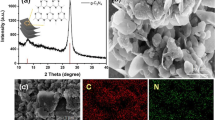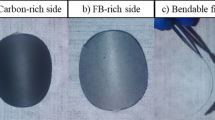Abstract
In quest of developing sustainable separator for lithium-ion batteries (LIBs), this research focuses on functionalization of low cost cellulose based commercial paper using duo-polymer and nano-SiO2 by designing a facile aqueous based industry friendly wet-coating process. Unlike commercial plastic based polyolefin separators (polypropylene/polyethylene), the developed paper separator shows superior thermal stability > 200 °C without dimensional shrinkage, excellent electrolyte wettability (147%) with zero contact angle, quicker electrolyte saturation and satisfactory mechanical strength (34.86–38.31 MPa). The electrochemical performance carried out in 2032 coin cells using fabricated paper separators shows comparable performance to that of commercial polypropylene (PP) based separator at different current densities of 0.05–0.4 mA/cm2 with excellent columbic efficiency (> 96%) and good capacity retention on cycling. The developed separator is found to be compatible with most of the commercial electrodes (MCMB, LiCoO2, LiFePO4) used in today’s LIBs. The functionalized cellulose-ceramic composite paper separator shows excellent flame retardant properties by offering an added safety features for its successful use in lithium-ion batteries.
Graphical abstract











Similar content being viewed by others
Data availability
The database used and/or analyses during the current study are available from the corresponding author on reasonable request.
References
Alongi J, Camino G, Malucelli G (2013) Heating rate effect on char yield from cotton, poly(ethylene terephthalate) and blend fabrics. Carbohydr Polym 92(2):1327–1334. https://doi.org/10.1016/j.carbpol.2012.10.029
Asadpoordarvish A, Sandström A, Larsen C, Bollström R, Toivakka M, Österbacka R, Edman L (2015) Light-emitting paper. Adv Funct Mater 25(21):3238–3245. https://doi.org/10.1002/adfm.201500528
Chena W, Shib L, Wang Z, Zhu J, Yang H, Mao X, Chib M, Sun L, Yuan S (2016) Porous cellulose diacetate-SiO2 composite coating on polyethylene separator for high-performance lithium-ion battery. Carbohydr Polym 147:517–524. https://doi.org/10.1016/j.carbpol.2016.04.046
Chetouani A, Elkolli M, Bounekhel M, Benachour D (2017) Chitosan/oxidized pectin/PVA blend film: mechanical and biological properties. Polym Bull 74:4297–4310. https://doi.org/10.1007/s00289-017-1953-y
Chun SJ, Choi ES, Lee EH, Kim JH, Lee SY, Lee SY (2012) Eco-friendly cellulose nanofiber paper-derived separator membranes featuring tunable nanoporous network channels for lithium-ion batteries. J Mater Chem 22(32):16618–16626. https://doi.org/10.1039/C2JM32415F
Deimede V, Elmasides C (2015) Separators for lithium-ion batteries: a review on the production processes and recent developments. Energ Technol 3(5):453–468. https://doi.org/10.1002/ente.201402215
Fang Z, Zhu H, Yuan Y, Ha D, Zhu S, Preston C, Chen Q, Li Y, Han X, Lee S, Chen G, Li T, Munday J, Huang J, Hu L (2014) Novel nanostructured paper with ultrahigh transparency and ultrahigh haze for solar cells. Nano Letter 14(2):765–773. https://doi.org/10.1021/nl404101p
Gogia A, Wang Y, Rai AK, Bhattacharya R, Subramanyam G, Kumar J (2021) Thin-film ceramic-coated separators for improved safety of lithium-ion batteries. ACS Omega 6(6):4204–4211. https://doi.org/10.1021/acsomega.0c05037
Ha D, Fang Z, Zhitenev NB (2018) Paper in electronic and optoelectronic devices. Adv Electron Mater 4(5):1700593–1700613. https://doi.org/10.1002/aelm.201700593
Jang ES, Kang CW, Jang SS (2018) Comparison of the mercury intrusion porosimerty, capillary flow porometry and gas permeability of eleven species of Korean wood. J Korean Wood Sci Technol 46(4):681–691. https://doi.org/10.5658/WOOD.2018.46.6.681
Laura V, Marianna L, Inse S, Linda R, Uldis G, Juris Z, Raphael P, Evelyn M (2017) Effect of chitosan on properties of paper for packagaing. Cellul Chem Technol 51(12):67–73. Corpus ID: 115142608
Lien DH, Kao ZK, Huang TH, Liao YC, Lee SC, He JH (2014) All-printed paper memory. ACS Nano 8(8):7613–7619. https://doi.org/10.1021/nn501231z
Liu C, Shao Z, Wang J, Lu C, Wang Z (2016) Eco-friendly polyvinyl alcohol/cellulose nanofiber-Li+ composite separator for high-performance lithium-ion battery. RSC Adv 6(100):97912–97920. https://doi.org/10.1039/C6RA18471E
Mirzaeian M, Abbas Q, Ogwu A, Hall P, Goldin M (2017) Electrode and electrolyte materials for electrochemical capacitors. Int J Hydrogen Energy 42(40):25565–25587. https://doi.org/10.1016/j.ijhydene.2017.04.241
Oliveira FC, Timmons AB, Lopes-da-Silva JA (2010) Preparation and characterization of chitosan/SiO2 composite films. J Nanosci Nanotechnol 10(4):2816–2825. https://doi.org/10.1166/jnn.2010.1442
Orendorff CJ (2012) The role of separators in lithium-ion cell safety. Interface-Electrochem Soc 21(2):61–65. https://doi.org/10.1149/2.F07122if
Osińska M, Walkowiak M, Zalewska A, Jesionowski T (2009) Study of the role of ceramic filler in composite gel electrolytes based on microporous polymer membranes. J Membr Sci 326(2):582–588. https://doi.org/10.1016/j.memsci.2008.10.036
Pingan H, Mengjun J, Yanyan Z, Ling H (2017) A silica/PVA adhesive hybrid material with high transparency, thermostability and mechanical strength. RSC Adv 7(5):2450–2459. https://doi.org/10.1039/C6RA25579E
Qolby S, Christin RR, Andri H, Titik L, Achmad S, Abdulloh R, Rike Y, Hiroshi U (2021) Preparation and characterization of nanofibrous cellulose as solid polymer electrolyte for lithium-ion battery applications. RSC Adv 11:22929–22936. https://doi.org/10.1039/D1RA03480D
Raja MW, Basu RN, Pramanik NC, Das PS, Das M (2022) Paperator: the paper-based ceramic separator for lithium-ion batteries and the process scale-up strategy. ACS Appl Energy Mater 5(5):5841–5854. https://doi.org/10.1021/acsaem.2c00188
Roberts JC (1996) The chemistry of paper. Royal Soc Chem-UK. https://doi.org/10.1039/9781847552068
Sugantha VK, Khaleel SB, Sudha PN (2012) Physicochemical and morphological evaluation of chitosan/poly(vinyl alcohol)/methylcellulose chemically cross-linked ternary blends. Polym Bull 68(5):1387–1393. https://doi.org/10.1007/s00289-011-0645-2
Sun C, Goharpey AH, Rai A, Zhang T, Ko DK (2016) Paper thermoelectrics: merging nanotechnology with naturally abundant fibrous material. ACS Appl Mater Interfaces 8(34):22182–22189. https://doi.org/10.1021/acsami.6b05843
Visakh PM, Yoshihiko A (2015) Flame retardants: polymer blends. Springer International Publishing-Switzerland, Composites and nanocomposites. https://doi.org/10.1007/978-3-319-03467-6
Wang Y, Jow J, Su K, Zhang J (2012) Development of the unsteady upward fire model to simulate polymer burning under UL94 vertical test conditions. Fire Saf J 54(1):1–13. https://doi.org/10.1016/j.firesaf.2012.08.001
Wang Z, Xiang H, Wang L, Xia R, Nie S, Chen C, Wang H (2018) A paper-supported inorganic composite separator for high-safety lithium-ion batteries. J Membr Sci 553(1):10–16. https://doi.org/10.1016/j.memsci.2018.02.040
Xu Q, Kong Q, Liu Z, Wang X, Liu R, Zhang J, Yue L, Duan Y, Cui G (2014) Cellulose/Polysulfonamide composite separator as a high performance lithium-ion battery separator. ACS Sustain Chem Eng 2(2):194–199. https://doi.org/10.1021/sc400370h
Xu G, Ding L, Wu T, Xiang M, Yang F (2019) Effect of PPR on the pore formation behavior and pore performances of β-iPP microporous membrane used for lithium-ion battery separator. J Polym Res 26:27. https://doi.org/10.1007/s10965-018-1689-x
Yang B, Wang L, Zhang M, Li W, Zhou Q, Zhong L (2021) Advanced separators based on aramid nanofiber (ANF) membranes for lithium-ion batteries: a review of recent progress. J Mater Chem A 9(22):12923–12946. https://doi.org/10.1039/D1TA03125B
Yao Y, Tao J, Zou J, Zhang B, Li T, Dai J, Zhu M, Wang S, Fu KK, Henderson D, Hitz E, Peng J, Hu L (2016) Light management in plastic-paper hybrid substrate towards high-performance optoelectronics. Energy Environ Sci 9(7):2278–2285. https://doi.org/10.1039/C6EE01011C
Yousaf J, Almajali E, Najjar ME, Amir A, Altaf A, Elahi M, Alja’afreh S S, Rmili H, (2022) Flexible, fully printable, and inexpensive paper-based chipless arabic alphabet-based rfid tags. Sensors 22(2):564–586. https://doi.org/10.3390/s22020564
Yuan B, Wen K, Chen D, Liu Y, Dong Y, Feng C, Han Y, Han J, Zhang Y, Xia C, Sun A, He W (2021) Composite separators for robust high rate lithium ion batteries. Adv Funct Mater 31(32):2101420. https://doi.org/10.1002/adfm.202101420
Zeng X, Liu Y, He R, Li T, Hu Y, Wang C, Xu J, Wang L, Wang H (2022) Tissue paper-based composite separator using nano-SiO2 hybrid crosslinked polymer electrolyte as coating layer for lithium ion battery with superior security and cycle stability. Cellulose 29:3985–4000. https://doi.org/10.1007/s10570-022-04499-5
Zhang SS (2007) A review on the separators of liquid electrolyte Li-ion batteries. J Power Sources 164(1):351–364. https://doi.org/10.1016/j.jpowsour.2006.10.065
Zhang Z, Zhou M, Yu J, Cai J, Yang Z (2021) Poly(vinylidene fluoride) modified commercial paper as a separator with enhanced thermal stability and electrolyte affinity for lithium-ion battery. Energy Environ Mater 4(4):664–670. https://doi.org/10.1002/eem2.12153
Zheng C, Xiang L, Jin W, Shen H, Zhao W, Zhang F, Di C, Zhu D (2019) A flexible self-powered sensing element with integrated organic thermoelectric generator. Adv Mater Technol 4(8):1900247–1900254. https://doi.org/10.1002/admt.201900247
Zhou ML, Zhang Z, Xu J, Wei J, Yu J, Yang ZY (2020) PDA modified commercial paper separator engineering with excellent lithiophilicity and mechanical strength for lithium metal batteries. J Electroanal Chem 868(1):114195. https://doi.org/10.1016/j.jelechem.2020.114195
Acknowledgments
The authors are thankful to the Director, CSIR-Central Glass & Ceramic Research Institute, Kolkata, India, for her permission to publish this work. The authors acknowledge the extensive support received from CSIR, India (Council of Scientific & Industrial Research, India) to develop the paper based separator as well as to design and fabricate an in-house-dedicated machine for scaling-up the developed separators under CSIR-sponsored projects-TAPSUN and FTT. The authors gratefully acknowledge the current financial support received from Department of Science & Technology, Government of India (DST, India).
Funding
The financial support received from Department of Science & Technology, Government of India (DST, India), Sanction No. DST/TMD/MECSP/2 K17/07 (G) dated 10.05.2019.
Author information
Authors and Affiliations
Contributions
Author MD helped in fabrication, data acquisition, analysis and interpretation of data. Author PSD helped in fabrication, physical characterization, mechanical testing, reviewed the manuscript. Author RNB conceptualized the idea and design of separator, revised the manuscript critically for important intellectual content. Author MWR conceptualized the idea and design of separator, analysed the data, prepared figures/plotting, analysed cell performance data and wrote the manuscript.
Corresponding authors
Ethics declarations
Competing interests
The authors declared that they have no competing interests.
Ethics approval and consent to participate
Not applicable.
Consent for publication
Not applicable.
Additional information
Publisher's Note
Springer Nature remains neutral with regard to jurisdictional claims in published maps and institutional affiliations.
Supplementary Information
Below is the link to the electronic supplementary material.
10570_2022_4873_MOESM1_ESM.docx
Fig.S1: Cycle No. vs Capacity plot of Untreated paper and functionalized paper separator (CPS15) at different current densities (0.1–0.4 mA/cm2); Fig.S2: Cycle No. vs Capacity plot of Untreated paper, Lowest Ceramic loaded (CPS01) and Highest Ceramic loaded (CPS15) paper separator at a current density of 0.2 mA/cm2. Fig.S3 Pore size distribution plot from BET absorption isotherm; Table S1 Specific surface area, average pore radius and total pore volume of fabricated paper separators (DOCX 23927 KB)
Rights and permissions
Springer Nature or its licensor holds exclusive rights to this article under a publishing agreement with the author(s) or other rightsholder(s); author self-archiving of the accepted manuscript version of this article is solely governed by the terms of such publishing agreement and applicable law.
About this article
Cite this article
Das, M., Das, P.S., Basu, R.N. et al. Cellulose-ceramic composite flexible paper separator with improved wettability and flame retardant properties for lithium-ion batteries. Cellulose 29, 9899–9917 (2022). https://doi.org/10.1007/s10570-022-04873-3
Received:
Accepted:
Published:
Issue Date:
DOI: https://doi.org/10.1007/s10570-022-04873-3




